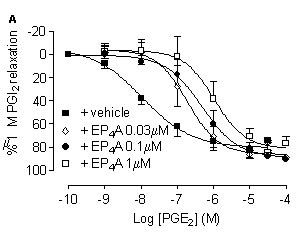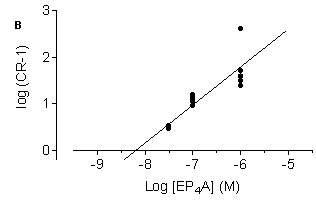| pA2 online © Copyright 2004 The British Pharmacological Society |
099P
University of Bath Summer Meeting July 2004 |
| Prostanoid EP4 receptors mediate relaxation of human middle meningeal artery C.E. Murdoch, R.A. Coleman, B.J. Clark, K.L. Clark & R.J. Davis Pharmagene Labs, Royston, Herfordshire. SG8 5HD. UK |
|
Venous blood levels of prostaglandin E2 (PGE2) are elevated in migraineurs during an attack (Satchielli et al, 2000), suggestive of a role for PGE2 in the pathophysiology of migraine. We have previously shown that PGE2, acting via EP4 receptors mediates vasodilatation of human cerebral arteries (Davis et al, 2004). The aim of the present study was to use the selective EP4 antagonist, EP4A (Machwate et al, 2001), to ascertain whether PGE2-induced relaxation in human middle meningeal arteries (HMMA) is mediated via EP4 receptors.
HMMA were obtained at autopsy with the informed consent of the donors’ next of kin and with the approval of the local ethics committee. HMMA were dissected from the dura mater, and intact rings (internal diameter <2mm) were mounted under isometric conditions in 10ml tissue baths under an initial tension of 5mN. All tissue rings were allowed to equilibrate for 60 min in Krebs solution at 37°C containing indomethacin (3 µM) and gassed with 95% O2/ 5% CO2. A cumulative concentration-effect curve (CEC) to phenylephrine (PE) (0.01 µM to 100 µM) was generated in all tissues. After washout, tissues were pre-incubated (60 min) with either EP4A (0.03 µM, 0.1 µM or 1 µM) or vehicle (0.1% DMSO), and then pre-contracted with an ~EC70 concentration of PE (10 µM). Once a stable PE contraction was obtained, a cumulative CEC to PGE2 (0.01 µM to 100 µM) was constructed. Prostacyclin (1 µM) was added at the end of the CEC to determine an approximate maximum relaxatory response of each tissue.
Results: Cumulative addition of PE to isolated rings of HMMA caused reproducible concentration-dependent contractions (pEC50 of 5.8 ±0.3, (n=4)). On PE pre-contracted HMMA rings, PGE2 caused concentration-dependent relaxations exhibiting a pEC50 of 8.0 ± 0.2 (n=10) (Figure 1A). Pre-treatment with the selective EP4 antagonist, EP4A (0.03 µM, 0.1 µM or 1 µM; n=3-7) caused a rightward surmountable shift of the PGE2 CEC. Schild analysis generated a plot EP4A with a slope not significantly different from unity (0.8 ± 0.1) and a pKB for of 8.2 (Figure 1B).


Figure 1. (A)Concentration-response curves to PGE2 in the absence and presence of various concentrations of the EP4 receptor antagonist, EP4A. (B)Schild analysis shown.
In the present study, we have demonstrated for the first time that EP4 receptors mediate PGE2-induced dilatation of pre-contracted HMMA. These data are consistent with the hypothesis that EP4 antagonists may be of potential clinical benefit in the treatment of migraine.
Davis, R.J. et al. (2004) Br. J. Pharmacol. 141, 580-585
Machwate, M. et al. (2001) Mol. Pharmacol. 60, 36-41
Satchielli, P. et al. (2000) Cephalalgia 20, 907-918